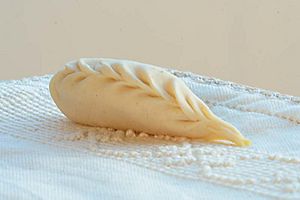Culurgiones facts for kids
 |
|
| Place of origin | Italy |
|---|---|
| Region or state | Sardinia |
Culurgiones are a special kind of pasta from Sardinia, an island in Italy. They look a bit like ravioli because they are stuffed. People in Sardinia call them by many names, like culurgionis or culurjones.
These tasty pasta pockets are usually filled with potatoes, a special Sardinian cheese called pecorino sardo, and fresh mint. This recipe is very popular in a part of Sardinia called Ogliastra. But in other areas, like Gallura, they might add lemon or orange peel for a different flavor!
Since 2015, the Culurgionis d'Ogliastra have been recognized as an IGP product. This means they are a special food that can only be made in a certain way and in a specific area, protecting their traditional quality.
Contents
Different Kinds of Culurgiones
Culurgiones can be made in several ways, depending on where you are in Sardinia. Each area has its own special recipe!
Ogliastra's Special Recipes
- In Ogliastra and nearby mountain areas, culurgiones are made with fresh durum wheat semolina dough.
- The filling often includes Sardinian pecorino cheese. Sometimes the cheese is fresh, and sometimes it's aged.
- Many recipes use potatoes, garlic, and mint in the filling.
- In one town, Bari Sardo, they use a sour cheese called fiscidu instead of pecorino. They also close the culurgione in a special way to make it look like a small ear of wheat.
- In Jerzu, they might use a plant called nepitedda instead of mint.
- After cooking in boiling water, culurgiones are often served with olive oil, or with tomato sauce and grated pecorino cheese.
- A special way of closing the pasta, called spighitta, is common in towns like Jerzu and Talana. This closing method looks like a braid.
- In the mountain parts of Ogliastra, the filling always has garlic. But near the coast, they use onion cooked in oil (called sofritta).
Culurgiones from Other Areas
- In Barbagia di Ollolai, which is also in Sardinia, culurgiones are filled with fresh pecorino cheese. They are served with tomato sauce and small pieces of pork, or with fresh sausage, all topped with grated pecorino cheese.
- In southern Sardinia, especially in the Campidano area, the recipes are different.
- Here, the pasta is filled with fresh ricotta cheese (from sheep or goat milk), egg, and saffron. Sometimes they add Sardinian pecorino cheese, nutmeg, chard, or spinach.
- After cooking, these culurgiones are served with fresh tomato sauce, a little chilli pepper, and basil. They are usually sprinkled with pecorino or other grated cheese.
- In Teulada, they prefer a simpler recipe. Their square-shaped culurgiones (called culixionis) are filled with fresh goat cheese. They are usually served with tomato sauce and grated goat cheese.
Why are Culurgiones Special?
Culurgiones are more than just food in Sardinia; they have a deep cultural meaning.
- In the village of Ulassai, people used to eat culurgiones only on All Souls' Day (November 2nd), a day to remember those who have passed away.
- Throughout Ogliastra and nearby villages, culurgiones are often given as gifts.
- They were traditionally made for special events, like celebrating the end of the wheat harvest.
- On All Souls' Day, they were made with sheep fat. For Carnival in February, they were made with lard.
- The spighitta closure, which looks like an ear of wheat, is a symbol of good luck for the new farming year.
- People also believed that culurgiones were like good luck charms that could protect families from sadness.
Other projects


